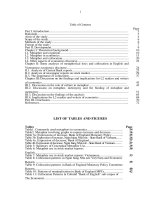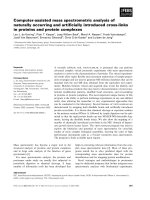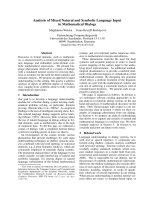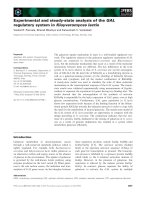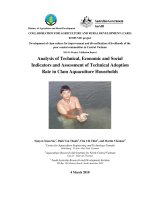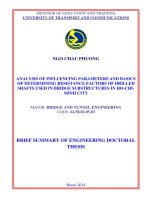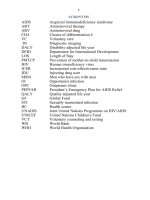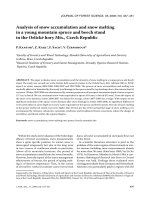Analysis of Chemical Toxicants and Contaminants in Foods
Bạn đang xem bản rút gọn của tài liệu. Xem và tải ngay bản đầy đủ của tài liệu tại đây (120 KB, 16 trang )
9
Analysis of Chemical Toxicants and
Contaminants in Foods
James N. Seiber
CONTENTS
Introduction
Who Performs Food Analysis and Why
Registration
Enforcement
Analytical Approach
Quality Parameters
Common Techniques and Methods
Conclusions
References
Introduction
Food is a complex chemical mixture, consisting of primary constituents such
as fat, protein, carbohydrates, fiber, moisture, and minerals, and what might
be termed “secondary” or “minor” constituents that include natural chemicals as well as those added which may influence the flavor, stability, longevity, mechanical handling, and other properties of foods. Many of these
secondary or minor constituents are intentionally added to foods, and thus
are regulated in terms of what and how much may be added. The legal definition of a food additive includes any chemical that is present in a food in
(normally) minor amounts at any time, either intentionally to produce a functional or technical effect or unintentionally as a consequence of the production, processing, storage, or packaging of a food item.1 This includes any
source of radiation, as well as those products (such as pesticide residues, and
© 2000 by CRC Press LLC
drugs and feed additives for food-producing animals) that are washed off or
removed in some way and do not appear, or cannot be detected, in the final
product as a result of processing.2
Contemporary concern over the safety of foods and, particularly, the addition either intentionally or unintentionally of chemicals which might be toxic
to the consumer, has given rise to an extensive array of analytical tests, many
of which are mandated by laws, regulations, or guidelines. The methods are
standardized by such organizations as the U.S. Food and Drug Administration (FDA), U.S. Department of Agriculture (USDA), U.S. Environmental
Protection Agency (EPA), Association of Official Analytical Chemists
(AOAC), Institute of Food Technologists (IFT), National Food Processors
Association, and the departments of agriculture of states such as California,
Florida, and Texas. For many intentional food additives, unintentional additives (such as pesticides), and some inorganics and natural toxicants, analyses are done routinely on sizeable percentages of shipments and lots — a
monitoring activity conducted by federal and state agencies, and by the food
industry and its trade organizations.
In this chapter the primary focus will be on chemical contaminant residues
in foods, with examples included primarily from among pesticides, but with
some reference to animal drugs, food additives, and some natural toxicants.
Most of the techniques used for pesticide residue analysis also are used for
animal drugs, natural toxicants, and the intentional food additives such as
antioxidant and antimicrobial preservatives. These classes of chemicals have
in common their predominately organic chemical structures, their presence
in foods at relatively low, often sub-ppm levels, and their tendency to coexist
with derived breakdown products which in many cases also must be
included in the analysis.
Who Performs Food Analysis and Why
Ultimately, all food analyses are conducted to safeguard the consumer, but
there are several more proximate reasons for doing so which have regulatory
and marketing imperatives. Methods are selected and used based upon the
specific needs of companies and agencies within the larger framework of consumer protection and food quality/safety needs.3
Registration
Companies that develop pesticides, animal drugs, and food additives must
develop methods capable of determining their potential product in or on the
crops, animals, and food-based products of intended use, and in the environment. The development of such methods may involve several iterations
© 2000 by CRC Press LLC
because the method must account for the parent and all toxicologically
important breakdown products in all products/environments in which the
chemical might ultimately be found as a residue. The breakdown products
and affected products/environments may not be completely known in the
development phase, so that an initial method may require several modifications. Feeding trials with experimental animals or dosing trials with crops
generally use radiolabelled parent chemicals, and analyses are based upon
radioassay of the parent and products in various tissues and excreta. These
studies are important for understanding conversion pathways, target organ
specificity, and clearance and accumulation pathways, but the methods are
not applicable to the subsequent needs for routine analytical methods for
ensuring the proper use and ultimate safety of the product when in largescale environmental testing or, eventually, in commercial use. Thus, methods
must be developed by the registrant for detecting unlabelled parent/conversion products which can be submitted to EPA (pesticide) or FDA (animal
drug or food additive) at the time the registration packet is submitted, so that
the appropriate regulatory agency can detect the product in the treated agricultural commodities and any food items prepared or processed from them.
These methods, after checking and validation, may ultimately find their way
into one or more compendia of analytical methods, or other appropriate references, such as the following:
Official Methods of Analysis of the Association of Official Analytical
Chemists.4 This compendium contains detailed methods for the
analysis of drugs, pesticides, metals, vitamins, food additives,
natural poisons, and other chemical and microbial contaminants
in food and feed.
Journal of the Association of Official Analytical Chemists. Same coverage
as the compendium of the AOAC, but including the results of
validation testing and new methods not yet incorporated in the
compendium.
Pesticide Analytical Manual.5 Volumes II and III contain detailed methods for all registered pesticides, applicable to the food and feed
items included in the pesticides’ label. Volume I contains multiresidue methods for use in screening and enforcement analysis, as
well as general directions for extraction, cleanup, and gas and high
performance liquid chromatographic (HPLC) determination.
Journal of Agricultural and Food Chemistry. Published by the American
Chemical Society and includes research articles on new methods
for crop and animal protection agents, flavors and aromas, additives, and contaminants. Many papers in this journal describe
breakdown pathways indicating what secondary products of the
parent pesticides, drug, or food additive may need to be included
in analysis.
© 2000 by CRC Press LLC
Enforcement
Regulatory agencies generally need to analyze foodstuffs for all toxic residues (e.g., all pesticides, all animal drugs, all toxic metals), and not just one
or two specific products. For this purpose, the single residue methods (SRMs)
developed by the registrant and described briefly in the previous section are
not appropriate. The regulatory methods are mostly “multiresidue methods”
(MRMs) capable of detecting and determining many chemicals in several
types of food products, and doing so in the somewhat routine, high volume,
rapid turn-around atmosphere of a large monitoring laboratory.6,7 A partial
listing of agencies and other entities that perform such monitoring activities
is in Table 9.1.
The volume of samples analyzed just for pesticide residues can be gauged
from the summary of FDA surveillance data cited in NRC3 and reproduced
in Table 9.2. The overall incidence of positives was small, averaging less than
5%, and most of these were nonviolative; that is, within established tolerances.8 Of the low incidence violations that do occur for pesticides, less than
1% are for over-tolerance violations while 5 to 10% are for the presence of residues in a food for which no tolerance has been established. This situation can
arise from carry-over of soil residue to a nontarget crop grown in a subsequent season or year, or from uptake of residue from the air or irrigation
water of the nontarget crop.
To summarize, SRMs are generally chosen when the sample is known or
suspected to contain a residue of a specific chemical. They are used when
there is some special concern over a given chemical in foods, such as occurred
during the contamination of watermelons by the pesticide aldicarb in the
1980s; the suspected contamination of flour, cake mixes, etc. with the fumigant
ethylene dibromide in the 1980s; and for such natural toxicants as the aflatoxins and potato alkaloids in contaminated foods — a continuing concern.
MRMs are chosen when the residue history of the sample is unknown, and the
question is, “Are pesticides present and, if so, how much of each?” MRMs will
provide information on a much broader range of chemicals than SRMs for a
similar investment of time and energy.9 The FDA and other agencies often use
simplified versions of SRMs to screen samples for potential violations before
proceeding to quantitation with a more elaborate MRM or SRM.
Analytical Approach
Whether a method is single or multiresidue in scope, it will include a series
of discrete steps or unit processes whose ultimate goal is to detect and quantify specific chemicals at levels of interest, in a relatively complex food
matrix. The matrix may contain hundreds or even thousands of natural and
man-made chemicals which can potentially interfere with the analyte(s) of
© 2000 by CRC Press LLC
TABLE 9.1
Agencies and Other Organizations that Conduct Monitoring Analysis of Foods
Name
Purview
Federal
Environmental Protection Agency
Food and Drug Administration
Food Safety and Inspection Service
Agricultural Marketing Service
Fish and Wildlife Service
Reviews and checks out analytical methods
for pesticides submitted by registrants
Monitors residues in imported and domestic
food, including processed food
Monitors residues in meat and poultry
Monitors residues in raw egg products
Monitors pesticides in fish and wildlife
State
California Department of Food and
Agriculture
Florida Department of Agriculture
Texas, New York, Oregon, Washington,
Massachusetts and other states
Monitors pesticides and other contaminants
in, primarily, fruits and vegetables
Monitors pesticides and other contaminants
in raw and processed foods
Monitor foodstuffs of specific interest to those
states
Universities
Cornell University, University of California,
Davis, University of Florida, Michigan State
University, and various satellite university
laboratories.
Conduct analyses for pesticides in minor
crops as part of the USDA IR-4 Minor Use
registration program
Industry
National Food Processors Association
General Mills, DelMonte, Campbell, and other
food companies
DowElanco, DuPont, Zeneca, Monsanto, and
other chemical companies
Monitor pesticide residues, other
additives/contaminants in fresh and
processed commodities
Monitor pesticides and other chemical
contaminants for their company’s products
Conduct analytical support for their own
products in food and environmental media
Private Laboratories
Commercial analytical laboratories
Conduct analyses for pesticides and other
toxicants (metals, solvents, additives) in
foods, soil, water, and wastes, under contract
with companies, agencies, and food
producers/processors
interest, often at concentrations many-fold higher than those of the analytes.
It is a proverbial “needle in the haystack” undertaking. Thus, methods are
designed to take advantage of unique physical properties, such as polarity,
volatility, and optical properties, and chemical properties (reactivity, complex
formation, combustion characteristics) which allow the analyte to stand out
© 2000 by CRC Press LLC
TABLE 9.2
Total of Samples and Positive Detections in FDA Residue Data
Chemical
Bromophos-ethyl
Dichlorvos
Prothiofos
Trichlorfon
Cyanophos
Ethoprop
Atrazine
Fonofos
Fenthion
Penthoate
Carbophenothion
O-Ethyl-O-p-nitrophenyl phenylphosphorothioate
Mecarbam
Dicrotophos
Ethylene Thiourea (ETU)
Fenitrothion
Quinalphos
Methoxychlor
Phorate
Phosphamidon
Chlorfenvinphos
Methomyl
Aldicarb
Phosalone
Profenofos
Disulfoton
Daminozide
Primiphos-methyl
Monocrotophos
Dicofol
Parathion-methyl
Benomyl
Ethylenebisdithiocarbamate
Phosmet
Methidathion
Azinphos-methyl
Parathion
Carbaryl
Diazinon
Ethion
Malathion
Mevinphos
Dimethoate
Captan
Chlorpyrifos
Acephate
Samples
(Total No.
Sampled)
No.
Positive
Percent (%)
Positive
113
763
1
1
912
1927
669
290
267
2328
7332
6912
1
1
1
1
2
2
4
4
6
10
11
12
0.9
0.1
100.0
100.0
0.2
0.1
0.6
1.4
2.2
0.4
0.1
0.2
16
15
22
5171
40
5643
40
3499
9299
2706
1141
11,857
9689
15,121
514
4449
18,617
12,430
30,361
1023
2539
15,604
15,948
15,320
40,029
11,212
35,896
30,588
39,226
25,639
40,496
30,108
45,418
39,940
14
15
15
30
30
36
36
63
66
69
76
82
105
117
125
176
191
216
240
292
296
335
437
474
591
632
648
699
1161
1320
1418
1499
2180
3845
87.5
100.0
68.2
0.6
75.0
0.6
90.0
1.8
0.7
2.5
6.7
0.7
1.1
0.8
24.3
3.9
1.0
1.7
0.8
28.5
11.6
2.1
2.7
3.1
1.5
5.6
1.8
2.3
2.9
5.1
3.5
5.0
4.8
9.6
Source: Based on unpublished FDA surveillance data, 1988 to 1989.
© 2000 by CRC Press LLC
from the forest of matrix-derived interferences. This theme is found in all of
the steps in analysis:10,11
• Extraction — Remove the analyte from the matrix, leaving the bulk
of the matrix behind as a filterable or nonvolatile mass. This is most
frequently accomplished by extraction with an organic solvent, but,
increasingly, “solventless” or solvent-minimizing methods are
being substituted.
• Cleanup — Remove unwanted coextractives by such operations as
column chromatography, liquid-liquid partitioning, volatilization,
or chemical degradation. The cleanup procedure also may result
in the fractionation of target analytes into subgroups, or fractions,
for further processing. This is particularly important in multiresidue analysis.
• Modification — Convert the target analyte to a derivative which is
more readily separated, detected, or quantitatively determined
than the parent. This is an optional step, reflecting the needs of
specific analytes and analyte classes. Modification may be done
pre- or post-cleanup, or after the resolution step in operations such
as post-column derivitization.
• Resolution — Separate the analyte from remaining interferences,
usually by some form of refined chromatography, such as gas chromatography (GC), high performance liquid chromatography
(HPLC), or ion chromatography (IC).
• Detection — Obtain a response related to the amount of analyte
present. Chromatographic detectors, spectrophotometers, and
mass spectrometers are the mainstays for achieving this objective,
although immunosorbent-based methods are coming into more
common use.
• Measurement — Relate the response of the analyte to some known
standard, of the analyte itself or a surrogate with similar properties,
for calculating the concentration in the original matrix. Integrating
recorders and computers are generally used for routine calculations.
• Confirmation — Provide assurance that the primary method gives
correct (i.e., accurate and precise) results, by use of a second, independent method. This has become much more important in recent
years due to the emphasis on quality assurance/quality control
(QA/QC) in the analytical laboratory.
Quality Parameters
There are several parameters by which one may judge the suitability of a
given method. Accuracy, or the agreement between the measured and true
value, is generally assessed by running a series of blanks spiked with known
© 2000 by CRC Press LLC
amounts of the target analyte(s), determining the end result of percent recovery (i.e., the amount recovered ÷ by the amount added × 100) or relative error
(the percent lost, or 100 – the percent recovered). Precision, or the reproducibilty of the method, is generally assessed by running replicates of the spiked
samples or of actual samples containing incurred residues. The relative standard deviation, or some other statistical parameter, is used.12 The total error
of the method is the sum of the accuracy (relative error) and precision (twice
the relative standard deviation) contributions.13 For food contaminants
which are relatively easy to determine with high accuracy and precision,
such as metals, the total error should be fairly small, on the order of 25% or
less. For some animal drugs, pesticides, natural toxicants, and metabolites,
total error may run well above 50%, but still be considered acceptable.13
Another important parameter is the limit of detection (LOD) which is
defined as the lowest concentration level of the analyte that can be determined to be different, with a high degree of confidence, from the blank or
background.14,15 The LOD is assessed by running several portions of the
blank or background matrix, i.e., substrate which lacks the analyte of interest,
through the method to be used to determine the analyte. If the substrate has
a high background of interfering material, which produce elevated absorbance readings at ultraviolet/visible measuring wavelengths, or spurious
peaks at retention times to be used in the determination of the analyte, the
LOD may be too high to permit analysis of the target analyte at levels of regulatory or toxicological interest. The limit of quantitation (LOQ) is a related
parameter that is selected as a cutoff point for the reporting laboratory; a residue may be detected, that is, be above the LOD, but still produce such a
small and sporadic signal that there can be little confidence in the concentration level calculated from the signal. The LOQ is typically several times
higher than the LOD, moving reponses to an area of greater confidence so
that the results truly represent, with high confidence, the concentration of target analyte in the matrix under investigation.15
Because analytical data is increasingly being used for risk assessment or for
making regulatory or economic decisions that can affect the availability of
chemicals or the safety of the food supply, it has become much more important that analytical chemists pay closer attention to the end data — its quality
and meaning — with less emphasis on simply running samples in order to
process the workload or inventory. The subjects of good laboratory practices
(GLP) and QA/QC are now much more familiar in the analytical laboratory
than just 10 years ago, partly because of the need to impose a mentality which
emphasizes quality and meaning in addition to speed and throughput.16
Common Techniques and Methods
Analytical chemistry has undergone an evolution (bordering on a revolution)
in methodology over the period dating roughly from the 1940s to the present.
© 2000 by CRC Press LLC
Bioassay, gravimetry
>1
Colorimetry, spectrophotometry
0.1
Paper, thin-layer chromatography
0.01
Gas and HP liquid chromatography
0.001
GC and LC/mass spectrophotometry
<0.0001
1940
1950
1960
1970
1980
Trend in Selectivity
Approximate Detection Limits, ppm
Trend in Cost
1990
Year (approximate)
FIGURE 9.1
The evolution of analytical methodology for organic toxicants in food and environmental
samples. (Modified from Seiber, J. N., Regulation of Agrochemicals, American Chemical Society,
Washington, D.C., 1991.)
The methods of today are generally more accurate and precise, more selective, and notably of much lower detection limits than those used in the 1940s
and 1950s (Figure 9.1). Primarily, this is due to the development and commercialization of a number of instruments for the detection and measurement of
chemicals of interest, and a much improved ability to distinguish between the
target analyte and some “mimic” which occurred in the same sample but is of
no interest to the analyst.7 For example, the only instruments of widespread
availability for quantitative analysis in the 1940s and 1950s were the balance
(used for gravimetric determination of chemicals that could be precipitated
and weighed) and the Beckman DU spectrophotometer and Bausch and
Lomb colorimeter (used for determining the absorbance of chemicals which
were colored (visible absorbers) or could form colored or strongly UV-absorbing derivatives). The bottom line was that, if it couldn’t be weighed or wasn’t
colored either as the parent or after modification, quantitative determination
was not possible and the best one could hope for was a qualitative determination based upon a bioassay endpoint. Detection limits were high and selective and, thus, confidence in the results were low. The advent of chromatography, starting with paper and thin-layer chromatography in the 1950s and
eventually evolving to gas and HPLC from, roughly, the 1960s to the present,
substantially lowered detection limits, to sub-ppm and ppb for most chemicals and provided much greater selectivity, and thus confidence, in the
results. Selective GC detectors have been particularly important in this
regard.17 Mass spectrometry represents, in many ways, the ultimate among
present-day instruments in terms of ability to select for specific targets at very
low levels and to ignore the extraneous material of no interest.
Similar developments occurred for metals and other inorganics. For metals,
the development of atomic absorption and atomic emission spectrophotometry
© 2000 by CRC Press LLC
in the 1950s and 1960s, and of the electrochemical techniques of polarography and voltammetry in the same period were of critical importance. The
advent of inductively coupled plasmas as heat sources for electronic excitation in AAS and AES, and of ICP-mass spectrometry for determination, represent state-of-the-art developments now finding increasing applications in
“routine” analyses. Many inorganic anions, such as nitrate, nitrite, cyanide,
and selenium anions, are best determined by the relatively new techniques of
ion chromatography and ion selective electrodes.18
Clearly, there has been a tradeoff in terms of investment and cost, such that
a modern analytical laboratory must have an array of highly sophisticated
and expensive instruments, and of equally sophisticated trained personnel to
maintain, run, and interpret the results of the instruments.19
The evolution of methods for pesticides is illustrative of the field. A general
methodology evolved which was heavily slanted toward pesticides of relatively high stability and low-to-medium polarity, and which contained a heteroatom such as chlorine, phosphorus, or sulfur, primarily because these
features recurred in the synthetic organic pesticides introduced in the
post-World War II era. Common organochlorine (OC) pesticides (such as
DDT, lindane, and dieldrin) and organophosphates (OPs) (such as parathion
and malathion) were, in fact, relatively nonpolar, so that they could be
extracted with an organic solvent, were of relatively high stability so that
they could be cleaned and/or fractionated on Florisil or silica gel adsorption
columns, and also were stable to common GC temperatures, in the 100 to
250°C range. Additionally, they contained chlorine or bromine, phosphorus,
or occasionally sulfur heteroatoms for detection using “element-selective”
GC detectors (Table 9.3). Background from the interferences which lacked the
heteroatoms, thus, was suppressed, and the analyte signal was enhanced,
TABLE 9.3
Selective GC Detectors Used in Pesticide Residue Analysis
Detector
Electron-capture (EC)
Microcoulometric (MC)
Alkali-flame (thermionic) (AFID)
NP-thermionic selective detector
(NP-TSD)
Electrolytic conductivity
Coulson (CECD)
Hall (HECD)
Flame photometric (FPD)
Thermal energy analyzer (TEA)
Photoionization (PID)
GC/MS (benchtop)
Ion trap (ITD)
Mass selective detector (MSD)
Atomic emission detector (AED)
© 2000 by CRC Press LLC
Basis for Selectivity
Year First Reported
(Approx.)
Halogen
Cl, Br, N, S
P, N
P, N
1959
1961
1964
1974
Cl, Br, N, S
Cl, Br, N, S
P, S
NO
Halogen, S, aromatics
1965
1974
1966
1975
1978
Diagnostic ions
Diagnostic ions
Several elements
1983
1984
1988
resulting in a much improved signal-to-noise ratio and a much improved
limit of detection.
Other analytical operations which suppressed background (such as
streamlined cleanup methods and the use of ultrapure solvents and reagents)
or enhanced the analyte signal (such as improved signal acquisition equipment) were built into the methods to support the lead role of the selective
detector. With this technology, detection limits of 0.01 ppm and lower were
readily attainable.
As pesticide chemistry changed to newer classes of chemicals, such as
N-methyl carbamate insecticides and synthetic pyrethroids that did not
always conform to the analytical prerequisites mentioned above, and as the
need for analysis of metabolites increased, and as the regulatory trend
toward testing at lower levels intensified, new technologies were introduced
to help keep pace. Some examples include:
• Capillary columns replaced packed columns in GC, dramatically
improving resolution and, through the additional modification of
bonded phase capillaries, durability and reproducibility.20 Microparticulate-packed columns had a similar influence on HPLC resolution, and capillary HPLC columns also are in increasing use.
• Solid phase extraction (SPE) is replacing solvent extraction, at least
for liquids, minimizing the use of organic solvents and the problems posed in their evaporation, handling, and disposal.21,22
• Automation of some routine operations, such as gel permeation
cleanup, some derivatization steps, and some partitioning and
evaporation steps, has replaced wet chemistry and minimized the
opportunity for error in some common procedures.7
• Mass spectrometry is in increasing routine use as a detection tool,
coupled to both GC and HPLC. The advent of low-cost, benchtop
instruments usable by virtually any chemist-technician has improved
the reliability of results, particularly in trace analyses.
Some of these modifications are apparent in the multiresidue methods of
the FDA and those used by the California Department of Food and Agriculture, which annually analyzes nearly as many samples of fruits and vegetables as the FDA.23 For example, in a current version of the CDFA MRM
(Figure 9.2), acetonitrile is used as a universal extracting solvent, and the
aqueous acetonitrile is cleaned up via reversed phase SPE cartridge technology.24 The recovered acetonitrile is then exchanged by evaporation to hexane,
for analysis of OCs by chlorine-selective GC, or acetone for analysis of OPs
and some organonitrogen compounds by FPD or NP-TSD GC. A separate aliquot is exchanged to methanol-methylene chloride, cleaned up on another
SPE column, and then exchanged to acetonitrile-water for HPLC with automated post-column derivatization for analysis of carbamates. Even more
recent modifications report the use of GC-MS in the selective ion monitoring
© 2000 by CRC Press LLC
Sample
1. Blend with acetonitrile
2. Filter
Filtrate
Residue
(discard)
SPE Cleanup
Aqueous
Acetonitrile
Cartridge
(discard)
Add NaCI
separate phases
Aqueous NaCI
(discard)
Acetonitrile
Exchange to
hexane then to
acetone
Filter
EC-GC
for OCs
Exchange to methanol-methylene chloride
Pass through amino-propyl SPE
Exchange to acetonitrile-water
HPLC/post-column
derivatization for
carbamates
FPD GC
for OPs
FIGURE 9.2
Multiresidue method used by California Department of Food and Agriculture for fruit and
vegetable samples. (Adapted from Seiber, J. N., Pesticide Residues in Food: Technologies
for Detection, U.S. Congress, Office of Technology Assessment, Washington, D.C., 1988, and
Lee, S. M. et al., Fresenius J. Anal. Chem., 399, 376, 1991.)
(SIM) mode as a single instrument replacement for the several element-selective GC detectors needed for prior versions of the MRM.25, 26 The SIM is programmed to scan for groups of ion masses that represent the common gas
chromatographable pesticides of regulatory interest.
More innovations are in the offing. New techniques are under development
for extracting organic toxicants from solid matrices, including most foods,
which eliminate or greatly minimize the use of organic solvents. One of these
is supercritical fluid extraction (SCFE), using as a solvent a common gas such
as carbon dioxide kept above its critical pressure-temperature point in a flowthrough extraction chamber.27,28 SCFE already enjoys some important uses in
the food industry, such as in removal of caffeine during decaffeination of coffee, removal of cholesterol from powdered eggs, and defatting of foods for
either consumption or analytical endpoints. In the latter case, SCFE can
© 2000 by CRC Press LLC
replace acid hydrolysis, Mojonnier, or Soxhlet extraction for total fat analysis.
In pesticide residue analysis, SCFE extraction is quicker, more reproducible,
more efficient, and safer when compared with organic solvent-based methods, leading to intensive efforts to utilize it in multiresidue methodologies.
An even more recent technique for accomplishing the same purpose as SCFE
is ASE — accelerated solvent extraction — in which common solvents such
as methanol are used in pressurized extraction chambers at temperatures
above their boiling points, resulting in more efficient mass transfer and, thus,
better extractabilities with less time and much reduced solvent volumes.29
Headspace sampling, as in headspace gas chromatography (HSGC), eliminates solvent extraction by determining residue in the vapor above the
matrix in a sealed, equilibrated vial.30,31 Examples in the food area are provided for various aromas and fragrances, and volatile pesticides such as
methyl bromide, ethylene oxide, and the dithiocarbamates that degrade to
carbon disulfide. HSGC is especially amenable to automation, with modules
capable of being loaded with as many as 100 prepared samples.
Immunoassay (IA) represents another promising newcomer to the analytical
chemists portfolio. Van Emon et al. 32 summarized applications to the analysis
of pesticides in foods. IA is widely touted as an alternative to the analytical
treadmill of improved analytical capability coupled to high-cost sophisticated
instrumentation such as mass spectrometry. Following a rather lengthy and
costly development process in which antibodies are recovered from an experimental animal exposed to a suitable derivative of the analyte of interest, and
formatting the assay for routine use, IA can provide many analyses at a
throughput rate and cost much improved over conventional approaches. An
interesting development is the availability of IA-based kits which can be used
in the field without any sophisticated instrumentation. The kit approach may
allow for screening of suspected contamination by a field inspector who then
diverts only the screen-positive samples to the lab for follow-up using GC or
GC-MS. This approach has the potential to reduce the volume of samples and,
thus, the costs in the laboratory without sacrificing consumer safety.
Many of these same techniques are under intensive examination, or have
already been adapted for other toxicant/additive classes in foods. SPE is now
in routine use for extracting aflatoxins from milk and juices prior to determination. IA methods are being used for aflatoxin screening and quantitative
analysis. Several animal drugs now have IA methods for use in residue regulatory compliance work.33 Holstege et al. 34 reported a new alkaloid multiresidue method which uses SPE and GC-MS for detecting alkaloids in food
animals exposed to alkaloid-bearing plants in their feed and forage.
Conclusions
The need for more and better analytical data will continue to stimulate developments in analytical chemistry applied to foods. Better methods are needed
© 2000 by CRC Press LLC
for chemicals of concern now, and new methods will be needed as additional
chemicals are added to the long lists of concerns in foodstuffs. The identification of domoic acid as the causative agent in food poisoning associated with
consumption of some shellfish has led to the development of an IA-based
method for screening seafoods for domoic acid.35,36 More examples are sure
to follow.
But improvements in LOD will no longer be the primary goal because
today’s detection limits will suffice for virtually any situation involving
potential health effects. In fact, if present-day LODs are lowered even more,
inadvertant residues will likely be found frequently in foodstuffs, but at levels well below those of any conceivable biological significance. A more likely
driver of analytical advances will be improved data quality at reduced costs,
and with greater flexibility in where the analysis can be performed (i.e., in the
field if needed) and the training and skill needed for the operator. Better and
more comprehensive multiresidue methods also will be needed to include
not only parent materials but also toxicologically significant residues. Miniaturization and automation also will be in demand, to replace the wet chemistry, hands-on methods of the past with all of their attendant potential for
error, lab personnel exposure, and slowness.
While pesticides, food additives, and animal health drugs have been the
stimulators of improved analytical methods because of their intense regulatory scrutiny, there are many other groups of chemicals which have been virtually ignored as foodborne residues but almost certainly exist as residues in
foods. Examples are provided by the organophosphorus plasticizers and fuel
additives, polynuclear aromatic hydrocarbons, phthalate ester plasticizers,
monomers and oligomers in plastic wraps and packaging, and naturally
occurring pesticides and other bioactive natural products.37 Analytical methods which can be applied to the whole gambit of chemical contaminants, not
just those which are the subjects of specific regulations, need to be developed
and placed in the repertoire of the laboratories responsible for analyzing
foods for public safety.
References
1. Federal Food, Drug, and Cosmetic Act, U.S. Code, Title 21, Section 321, U.S.
Government Printing Office, Washington, D.C., 1983.
2. York, G. and Gruenwedel, D. W., Food additives, in Chemicals in the Human
Food Chain, Winter, C. K., Seiber, J. N., and Nuckton, C.F., Eds., Van Nostrand
Reinhold, New York, 1990, 87.
3. National Research Council, Pesticides in the Diets of Infants and Children, National
Academy Press, Washington, D.C., 1993, 6.
4. Association of Official Analytical Chemists, Official Methods of Analysis, 15th
ed., Arlington, VA, 1990, 1-2.
© 2000 by CRC Press LLC
5. Food and Drug Administration, Pesticide Analytical Manual, U.S. Department
of Health and Human Services, Washington, D.C., 1994.
6. McMahon, B. and Burke, J., Expanding and tracking the capabilities of pesticide
residue methodology used in the Food and Drug Administration’s pesticide
monitoring programs, J. Assoc. Off. Anal. Chem., 20, 1073, 1988.
7. Office of Technology Assessment (OTA), Pesticide Residues in Food: Technologies for Detection, U.S. Congress, Office of Technology Assessment, Washington, D.C., 1988, 232.
8. Archibald, S. 0. and Winter, C. K., Pesticides in our food — assessing the risks,
in Chemicals in the Human Food Supply, Winter, C. K., Seiber, J. N., and Nuckton,
C. F., Eds., Van Nostrand Reinhold, New York, 1990, 1.
9. Seiber, J. N., Conventional pesticide analytical methods: can they be improved?
in Pesticide Residues in Food: Technologies for Detection, U.S. Congress, Office
of Technology Assessment, Washington, D.C., 1988, 142.
10. Seiber, J. N., New trends in analytical methods for pesticide residues in foods,
in Pesticide Residues and Food Safety, Tweedy, B. G., Dishburger, H. T., Ballantine,
L. G., and McCarthy, J., Eds., ACS Symposium Book 446, American Chemical
Society, Washington, D.C., 1991.
11. Seiber, J. N., Analytical chemistry and pesticide regulation, in Regulation of
Agrochemicals, Marco, G. J., Hollingworth, R. M., and Plimmer, J. R., Eds.,
American Chemical Society, Washington, D.C., 1991.
12. Garber, M. J., Statistical evaluation of results and sampling procedures, in
Analytical Methods for Pesticides and Plant Growth Regulations, Zweig, G. and
Sherman, J., Eds., Academic Press, New York, 1986, 19.
13. McFarren, E. R, Likssa, R. J., and Parker, J. H., Criterion for judging acceptability
of analytical methods, Anal. Chem., 42, 358, 1970.
14. Sutherland, G. A., Residue analytical limit of detectability, Res. Rev., 10, 85, 1965.
15. Keith, L. H., Crummett, W., Deegan, J., Jr., Libby, R. A., Taylor, J. K., and Wentler,
G., Principles of environmental analysis, Anal. Chem., 55, 2210, 1983.
16. Garner, N. Y. and Barge, M. S., Good Laboratory Practices: An Agrochemical Perspective, ACS Symposium Series 369, Washington, D.C., 1988.
17. Sievers, R. E., Selective Detectors: Environmental, Industrial, and Biomedical Applications, John Wiley & Sons, New York, 1995, 221.
18. Willard, H. H., Merritt, L. L., Jr., Dean, J. A., and Settle, F. A., Jr., Instrumental
Methods of Analysis, 7th ed.,Wadsworth, Belmont, 1988.
19. Demenna, G. J. and Brown, G. J., Analytical techniques for today’s food industry: a primer, Food Test. Anal., 1, 33, 1995.
20. Jennings, W., Gas Chromatography with Glass Capillary Columns, 2nd ed., Academic Press, New York, l980.
21. Boyd-Boland, A. A., Chai, M., Luo, Y. Z., Zhang, Z., Yang, M. J., Rawliszyn,
J. B., and Goreck, T., New solvent-free sample preparation techniques. Environ.
Sci. Technol., 28, 569A, 1994.
22. Shirey, R. E., Woolley, C. L., and Mindrup, R. F., Solventless extraction of flavors
and other food components, Food Test. Anal., Aug-Sept, 39, 1995.
23. Luke, M. A., The evolution of a multiresidue pesticide method, in 8th International
Congress of Pesticide Chemistry: Options 2000, Ragsdale, N. N., Kearney, P. C., and
Plimmer, J. R., Eds., American Chemical Society, Washington, D.C., 1995, 174.
24. Lee, S. M., Papathakis, M. L., Fong, H. C., Hunter, G. F., and Carr, J. E.,
Multipesticide residue method for fruits and vegetables: California Department
of Food and Agriculture, Fresenius J. Anal. Chem., 399, 376, 1991.
© 2000 by CRC Press LLC
25. Cairns, T., Luke, M. A., Chiu, K. S., Navarro, D., and Siegmund, E., Multiresidue
pesticide analysis by ion-trap technology: a clean-up approach for mass spectral analysis, Rapid Commun. Mass Spec., 7, 1070, 1993.
26. Cairns, T. and Baldwin, R. A., Pesticide analysis in food by mass spectrometry,
Anal. Chem., 67, 552A, 1995.
27. King, J. W., Fundamentals and applications of supercritical fluid extraction in
chromatographic science, J. Chromatogr. Sci., 27, 355, 1989.
28. Jinno, K., Hyphenated techniques in supercritical fluid chromatography and
extraction, in Journal of Chromatography Library Series, Jinno, K., Ed., Elsevier
Publishers, New York, 1992, 53.
29. Ezzell, J. L., Richter, B. E., Felix, W. D., Black, S. R., and Meikle, J. E.,
A comparison of accelerated solvent extraction with conventional solvent extraction for organophosphorus pesticides and herbicides, LC-GC, 13, 1995, 390.
30. Kolb, B., Applied Headspace Gas Chromatography, Heyden, London, 1980, 185.
31. Khan, S. U., Supercritical fluid extraction of bound pesticide residues from soil
and food commodities, J. Agric. Food Chem., 1718, 1995.
32. Van Emon, J. M., Seiber, J. N., and Hammock, B. D., Immunoassay techniques
for pesticide analysis, in Analytical Methods for Pesticides and Plant Growth Regulators, Vol. XVII, Sherma, J., Ed., Academic Press, New York, 1989, 217.
33. Muldoon, M. T., Elissalde, M. H., Beier, R. C., and Stanker, L. A., Development
and validation of a monoclonal antibody-based enzyme-linked immunosorbent assay for salinomycin in chicken, J. Agric. Food Chem., 43, 1745, 1995.
34. Holstege, D. M., Seiber, J. N., and Galey, F. D., Rapid multiresidue screen for
alkaloids in plant material and biological samples, J. Agric. Food Chem., 43, 699,
1995.
35. Quilliam, M. A. and Wright, J. L. C., The amnesic shellfish poisoning mystery,
Anal. Chem., 61, 1053A, 1989.
36. Smith, D. S. and Kitts, D. D., Enzyme immunoassay for the determination of
domoic acid in mussel extracts, J. Agric. Food Chem., 43, 3 67, 1995.
37. Seiber, J. N., Industrial and environmental chemicals in the human food chain.
II. Organic chemicals, in Chemicals in the Human Food Chain, Winter, C. K., Seiber,
J. N., and Nuckton, C. F., Eds., Van Nostrand Reinhold, New York, 1990, 183.
© 2000 by CRC Press LLC
